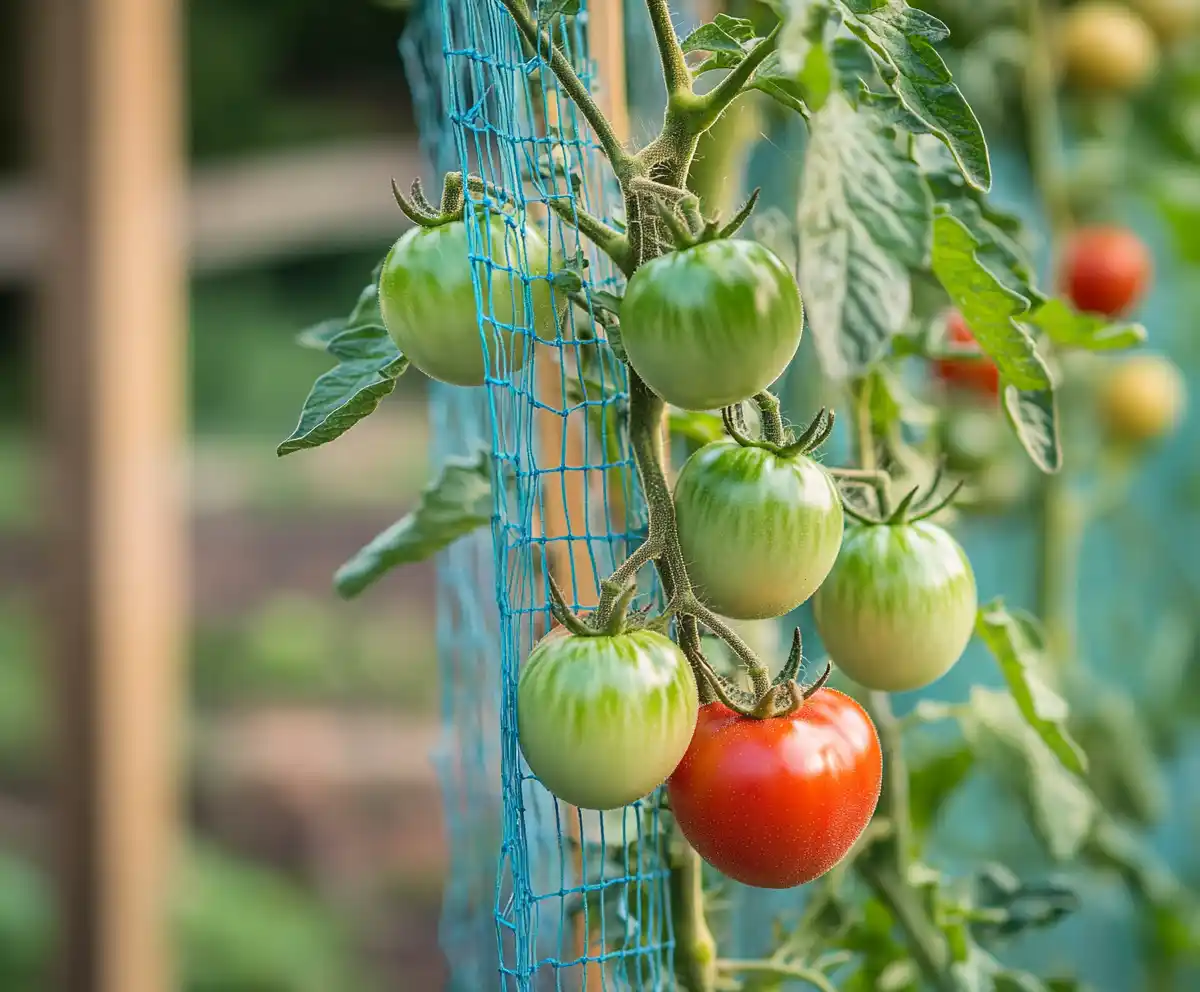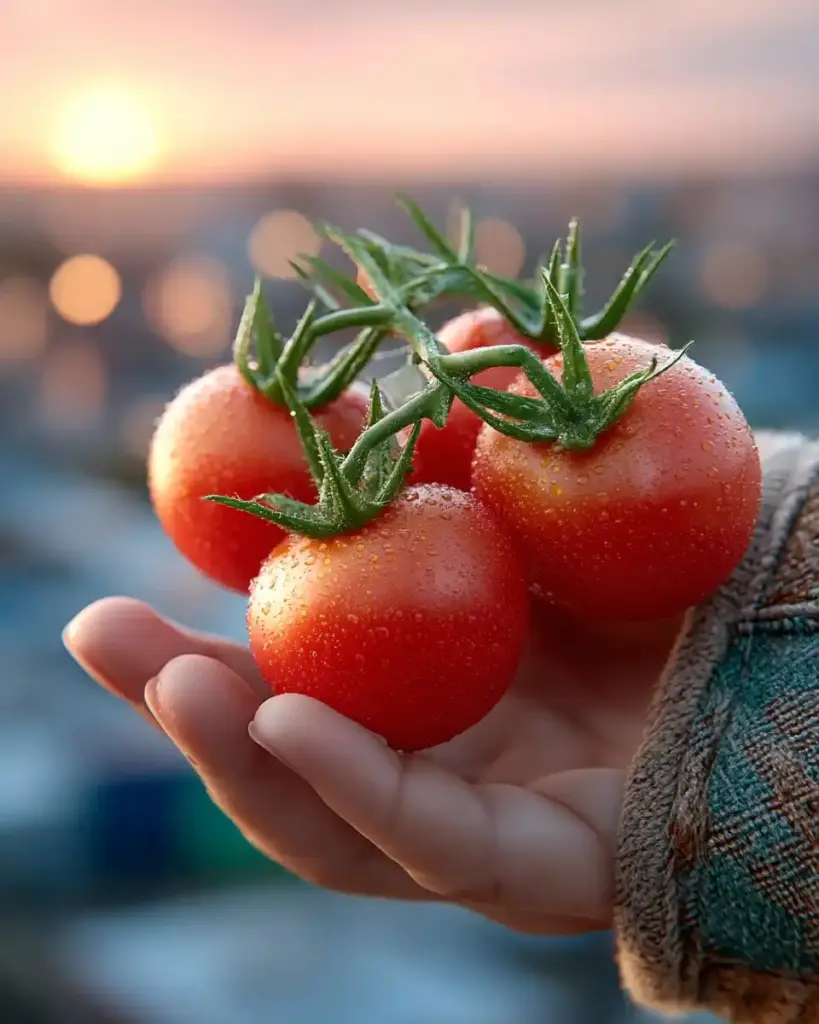If you’ve ever grown tomatoes, you know how quickly their vines can sprawl out of control. That’s why having the right tomato trellis ideas is essential for any garden — whether you’re working with pots on a balcony or a backyard bed. Trellising not only improves air circulation and protects plants from pests and disease, but it also makes harvesting easier and keeps your garden looking neat.
Looking to expand your garden vertically beyond tomatoes? Check out these cucumber trellis ideas for more ways to maximize space and yield.
Table of Contents
Why Use a Trellis for Your Tomatoes?
Tomatoes are vigorous growers. Left unsupported, their vines quickly sprawl along the ground, becoming vulnerable to rot, pests, and disease. That’s why incorporating smart tomato trellis ideas into your garden setup is more than just a tidy trick — it’s a game-changer for plant health and productivity.
Here’s why a trellis makes such a difference:
- Keeps Vines Off the Ground: By elevating the plants, a trellis protects leaves and fruit from soil-borne pathogens and moisture that can cause rot.
- Improves Air Circulation: Better airflow reduces the risk of fungal diseases and keeps your plants drier and healthier.
- Simplifies Maintenance and Harvesting: Pruning, watering, and harvesting become easier when everything is lifted and clearly visible.
- Boosts Fruit Production: Healthy, supported tomato plants typically yield more and higher-quality fruit.
- Adds Visual Appeal: Trellised tomatoes bring vertical interest and structure to your garden space.
Whether you’re gardening in raised beds, containers, or a backyard plot, choosing the right tomato trellis ideas will give your plants the structure they need to thrive.
1. Single Stake Trellis
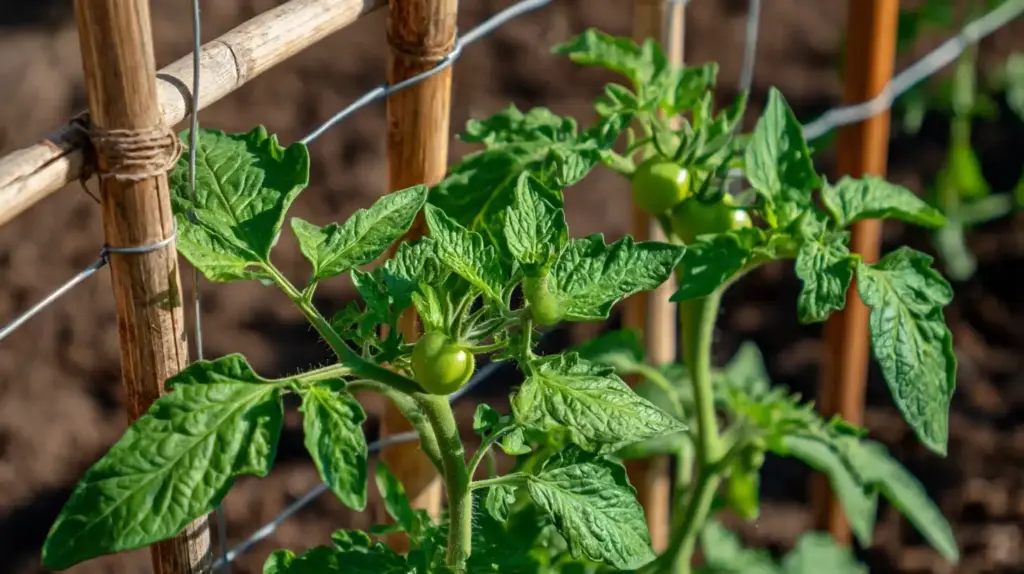
The single stake trellis is one of the simplest and most accessible tomato trellis ideas, perfect for new gardeners or anyone working with limited space. This method involves supporting each tomato plant with an individual stake, allowing the vine to grow vertically with gentle guidance.
How to Set It Up
- Choose a 5- to 6-foot tall wooden or metal stake.
- Insert the stake about 12 inches deep into the soil, 2–3 inches away from the base of your tomato plant.
- As the plant grows, loosely tie the main stem to the stake every 10–12 inches using soft garden twine, cloth strips, or plant ties to avoid damaging the stem.
Best For
- Determinate tomatoes (also known as bush varieties), which grow to a fixed height and produce fruit in a short window.
Pros
- Very budget-friendly and easy to implement.
- Great for small gardens or container setups.
- Helps keep plants upright and tidy.
Cons
- Requires regular attention to re-tie the plant as it grows.
- Not strong enough for indeterminate tomatoes, which grow tall and heavy over the season.
If you’re just starting out and want to keep things simple, this is a great first step in exploring effective tomato trellis ideas without overwhelming complexity.
2. Cage Trellis
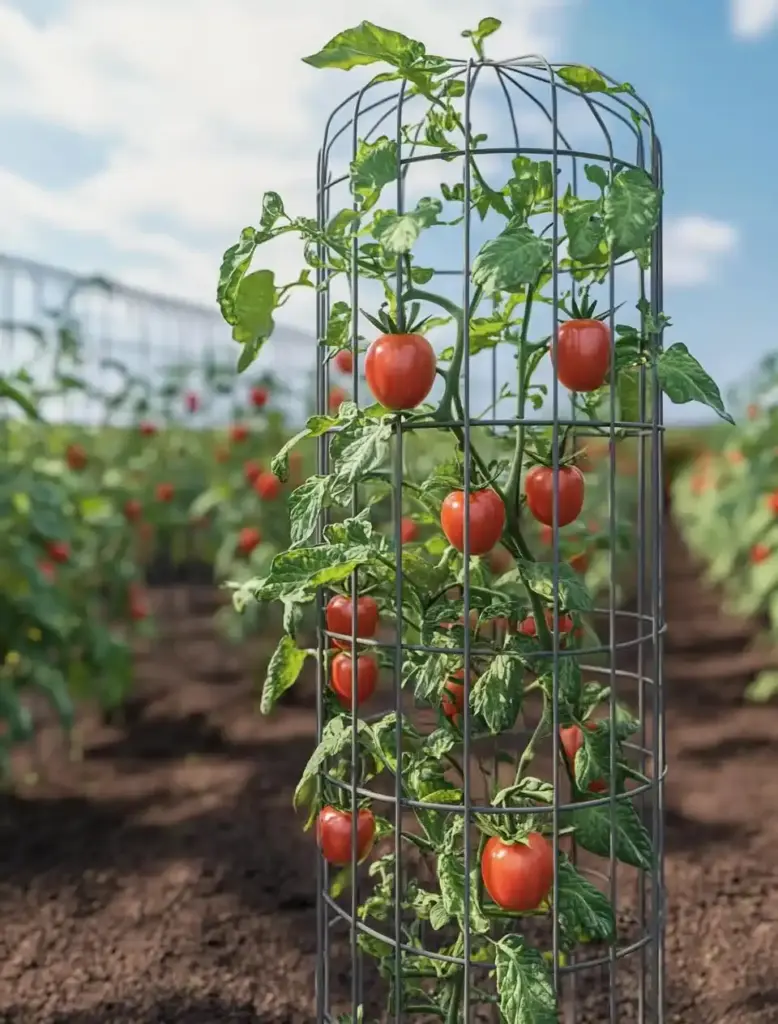
Among the most popular tomato trellis ideas for beginners, the cage trellis offers a no-fuss way to support growing tomato plants. Designed to surround the plant on all sides, a tomato cage allows the plant to naturally grow upward and outward, using the cage’s rings for support.
How to Set It Up
- Select a metal tomato cage, typically 3 to 5 feet tall, depending on the tomato variety.
- Place the cage directly over the young plant shortly after transplanting.
- As the plant matures, it will naturally weave itself through the cage’s structure for support.
- If necessary, secure stems to the cage with soft ties to guide growth.
Best For
- Both determinate and small indeterminate tomato varieties.
- Ideal for gardeners who want low-maintenance solutions.
Pros
- Very easy to use — just set it and let the plant grow.
- Provides support from all angles.
- Minimal tying or pruning required.
- Great for container gardening or raised beds.
Cons
- Can be bulky, especially in small gardens.
- May not support large or very heavy indeterminate plants late in the season without reinforcement.
Cage trellises are perfect for gardeners who want a sturdy, passive solution that still aligns with smart tomato trellis ideas — especially if you’re juggling a busy schedule or a compact space.
3. Florida Weave Trellis
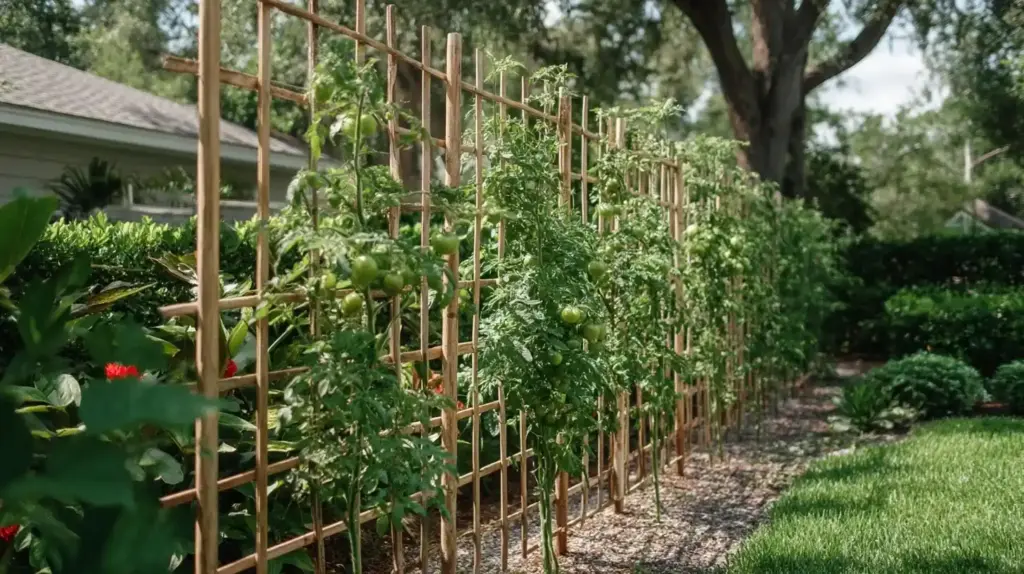
If you’re growing several tomato plants in a row, the Florida Weave is one of the most efficient tomato trellis ideas to keep your garden tidy and productive. Commonly used by commercial growers and home gardeners alike, this method combines vertical support with a weaving technique that holds multiple plants upright.
How to Set It Up
- Place sturdy stakes (wooden or metal) between every two or three tomato plants.
- Starting about 8 inches above the ground, weave garden twine from one stake to the next, looping around each one as you go.
- Repeat this weaving pattern every 8–12 inches vertically as the plants grow taller.
- Gently tuck branches between the twine rows to help support growth.
Best For
- Rows of determinate tomatoes.
- Gardeners with multiple tomato plants planted in beds or long containers.
Pros
- Strong, shared support for multiple plants.
- Uses minimal materials compared to individual cages or stakes.
- Great for maximizing row planting efficiency.
Cons
- Requires regular attention to add new twine layers as plants grow.
- Takes a bit of practice to master the weaving technique effectively.
If you’re planting in rows and want a clean, uniform setup, the Florida Weave is a practical and resourceful option among popular tomato trellis ideas — and one that scales well for larger plantings.
4. A-Frame Trellis
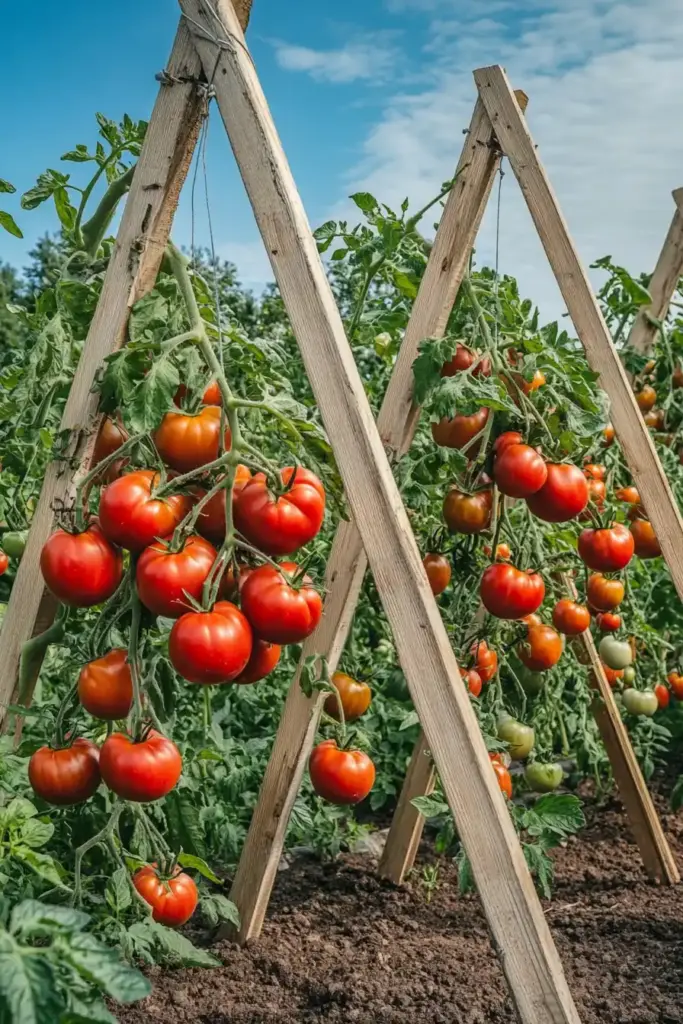
The A-frame trellis is a sturdy and visually striking option that works especially well for tall, vining tomatoes. Among DIY-friendly tomato trellis ideas, this one offers serious strength and structure, making it ideal for indeterminate varieties that need long-term support.
How to Set It Up
- Build two slanted panels using wood or metal and join them at the top to form an “A” shape.
- Secure the top with screws, hinges, or rope ties to keep the structure stable.
- Add horizontal crossbars, netting, or garden twine across the panels to give vines something to climb.
- Plant tomatoes near the base and train the vines to grow upward and outward.
Best For
- Indeterminate tomatoes that continue growing throughout the season.
- Gardeners with ample space for a larger structure.
Pros
- Extremely durable — supports heavy fruit and large plants.
- Offers vertical and angled support, great for training vines.
- Adds a beautiful focal point to any garden space.
Cons
- Requires DIY effort and basic construction tools.
- Takes up more space than simpler trellising methods.
If you’re growing ambitious varieties or want to create a more architectural garden element, the A-frame is one of the most robust and rewarding tomato trellis ideas you can build.
5. String Trellis (Vertical String Method)
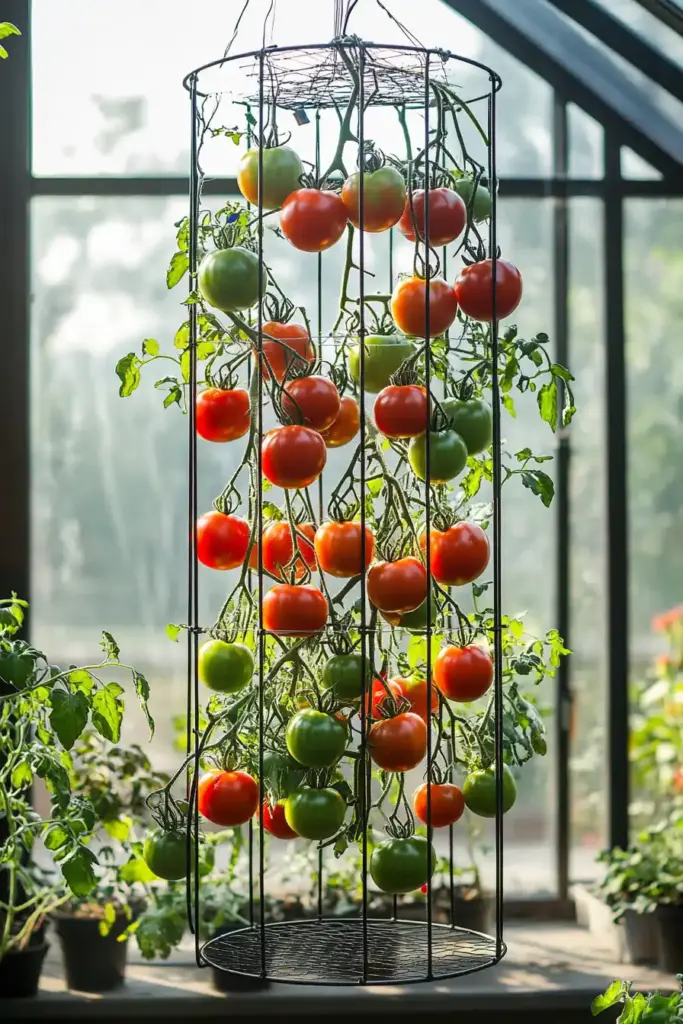
For gardeners working with greenhouses, patios, or compact vertical setups, the string trellis — also called the vertical string method — stands out as one of the most space-efficient tomato trellis ideas. This minimalist approach uses hanging strings to guide upward vine growth, making it perfect for indeterminate tomatoes grown in protected environments.
How to Set It Up
- Install a horizontal support bar or beam (wood, PVC, or metal) about 6–7 feet above your tomato plants.
- Tie a strong string or garden twine from the beam, then anchor it securely at the plant’s base.
- As the tomato grows, gently wrap the main stem around the string or use soft ties to guide its path upward.
Best For
- Indeterminate tomatoes grown in greenhouses, under pergolas, or patios with overhead structures.
- Gardeners seeking a sleek, vertical system that saves floor space.
Pros
- Extremely space-saving — great for tight or indoor spaces.
- Keeps plants upright and orderly.
- Makes harvesting and pruning easy due to open vine structure.
Cons
- Needs a sturdy overhead support that won’t sag or collapse under weight.
- Not ideal for outdoor exposure unless there’s adequate wind protection.
When garden space is limited but vertical height is available, the string trellis is one of the most elegant and functional tomato trellis ideas — especially for advanced or greenhouse growers.
Tips for Trellis Success
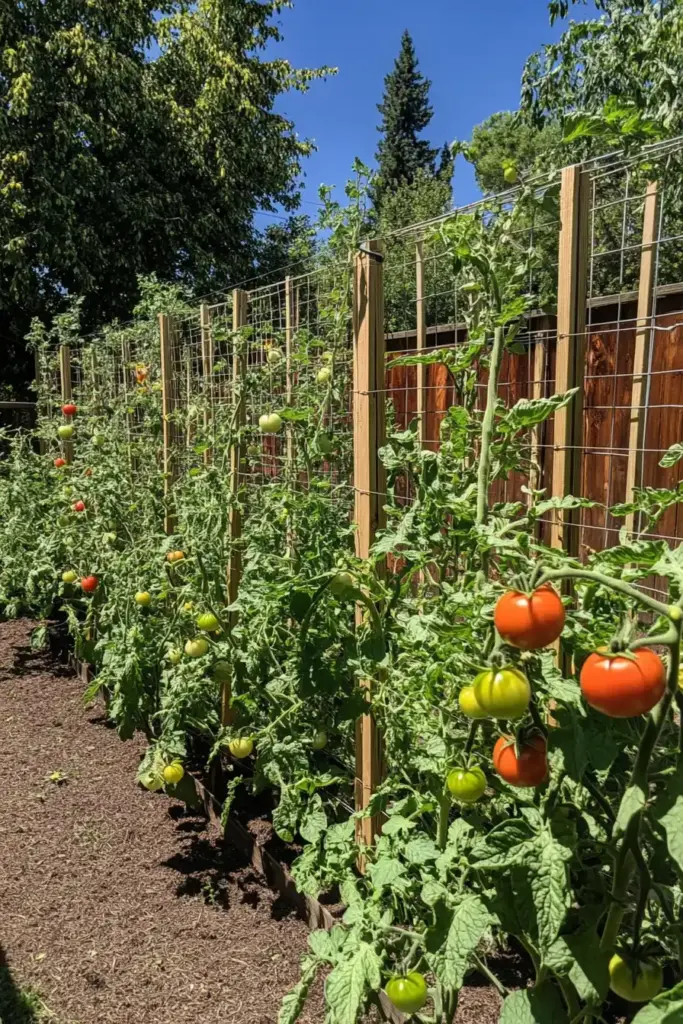
No matter which of these tomato trellis ideas you choose, getting the most from your setup requires a few practical techniques. These tips will help ensure your tomatoes grow strong, stay healthy, and produce generously throughout the season.
1. Use Soft Ties
When applying any of these tomato trellis ideas, it’s essential to support your plants without harming them. One of the easiest ways to do this is by using soft ties — such as garden twine, cloth strips, or Velcro plant ties — instead of harsh materials like wire or plastic string. As tomato stems grow and thicken, rough or rigid ties can cut into the plant, leading to wounds that invite disease or stunt growth.
Whether you’re working with a single stake, a string trellis, or an A-frame system, using flexible, gentle ties helps your tomatoes climb safely and thrive. If you’re building your own structure, check out these DIY trellis ideas for vertical gardening to pair smart design with plant-safe materials from the very beginning.
2. Check and Adjust Regularly
Tomatoes are fast growers, especially during the height of the season — and without consistent attention, even the best tomato trellis ideas can fall short. To keep your plants thriving, make it a weekly habit to inspect and adjust your trellis system. This includes retying soft ties if they loosen, wrapping new vine growth gently around your support structure, and correcting any stems that have fallen or veered off course.
A little maintenance goes a long way in preventing tangled vines, broken branches, and airflow issues that can lead to disease. If you’re using systems like the Florida Weave or vertical string method, regular upkeep becomes even more critical. For more ideas that support healthy, upright growth, explore these DIY garden trellis strategies that make ongoing adjustments easier to manage.
3. Prune for Health and Productivity
Pruning is one of the most important — yet often overlooked — steps when implementing effective tomato trellis ideas. Regular pruning keeps your tomato plants open and well-ventilated, which is crucial for reducing the risk of fungal diseases like blight and powdery mildew. It also channels the plant’s energy into producing larger, healthier fruit instead of excess leafy growth.
Focus on removing lower leaves that touch or hover near the soil, as these are most susceptible to moisture and disease. You should also pinch off suckers — the small shoots that grow between the main stem and leaf branches — especially if you’re growing indeterminate varieties that tend to get wild.
Pairing smart pruning with the right support system can dramatically increase yields. To design a space that supports vigorous, high-output plants, explore these vegetable garden ideas to create a productive setup that thrives all season long.
4. Match Trellis Type to Tomato Variety
One of the most important steps in choosing the right tomato trellis ideas is understanding the difference between determinate and indeterminate tomato varieties. Each type has unique growth habits — and your trellis should match accordingly to provide the best support.
Determinate tomatoes, also known as bush varieties, grow to a fixed height and produce fruit over a short period. These plants benefit from shorter, simpler trellises like single stakes or tomato cages, which are easy to install and require minimal maintenance.
On the other hand, indeterminate tomatoes keep growing and fruiting throughout the season. These vigorous growers need taller, more robust structures such as A-frame trellises, the Florida Weave, or vertical string methods to keep them off the ground and properly trained.
Planning your layout around your tomato type can make a huge difference in productivity. To build a garden that supports strong, healthy growth, check out these vegetable garden layout ideas and set your tomatoes up for success from the start.
5. Watch the Weather
If you’re using outdoor trellis methods, ensure your structure is wind-resistant. Reinforce taller trellises or add guy lines if needed to prevent collapse in high winds.
Taking the time to manage your trellis system effectively ensures that your tomato plants remain productive, healthy, and easy to care for — all key goals behind the best tomato trellis ideas.
Frequently Asked Questions (FAQ)
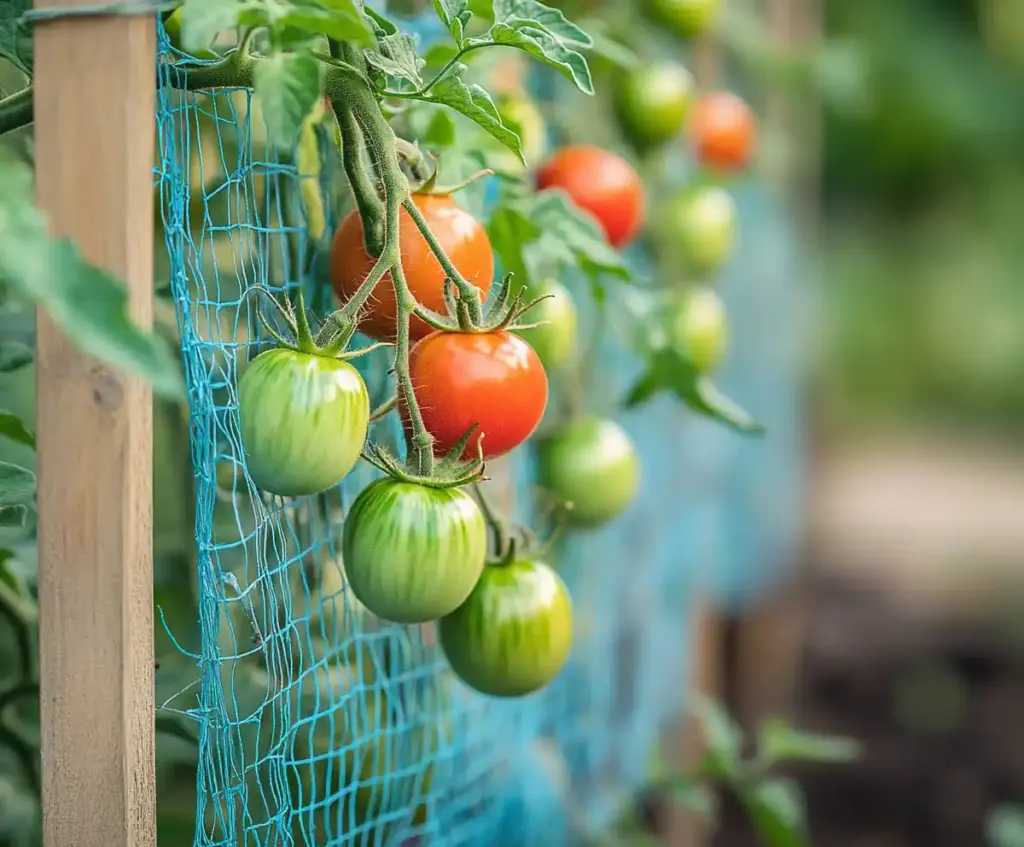
❓What is the best trellis for tomatoes?
The best tomato trellis ideas vary based on two main factors: your tomato variety and the space available in your garden. For compact, determinate (bush) tomatoes, simple solutions like single stakes or cage trellises provide plenty of support without overwhelming your space. These are great for container gardening or raised beds where height and spread are limited.
On the other hand, indeterminate (vining) tomatoes grow vigorously throughout the season and need sturdier, taller support systems. Options like A-frame trellises, the Florida Weave, or the vertical string method offer strong and scalable solutions that keep vines upright, reduce disease risk, and make harvesting a breeze.
If you’re trying to decide which structure fits your needs, browse through our best trellis ideas for vertical gardening — a helpful guide packed with practical setups for gardens of all sizes and tomato types.
❓Can I use bamboo stakes for tomato trellising?
Yes, bamboo stakes are one of the most popular and eco-friendly materials for implementing simple tomato trellis ideas — especially the single stake method. Bamboo is lightweight, renewable, and surprisingly durable when properly installed. For best results, choose stakes that are 5 to 6 feet tall, and make sure they’re driven at least 12 inches deep into the soil to prevent tipping as your tomato plant matures and becomes top-heavy.
This method works particularly well for determinate tomato varieties, which don’t grow excessively tall. For even more natural, low-cost ideas, you might enjoy these DIY trellis tips for vertical gardening, perfect for both beginners and experienced gardeners looking to add rustic charm to their growing space.
❓How tall should a tomato trellis be?
When it comes to tomato trellis ideas, height matters — and it all depends on the type of tomato you’re growing. Indeterminate varieties, which continue to grow and produce fruit throughout the season, typically need 6 to 7 feet of vertical support to accommodate their climbing habit and prevent stem breakage. In contrast, determinate (bush) tomatoes usually reach a set height and can thrive with trellises between 4 to 5 feet tall.
Matching the height of your trellis to the specific growth habit of your tomato variety ensures better structure, airflow, and easier pruning. If you’re building your own support, consider referencing these DIY garden trellis ideas to find designs that work for a range of tomato types and growing spaces.
❓When should I install the trellis?
The best time to install your trellis is right at planting time, or at the very latest, within a few days after transplanting your tomato seedlings. Installing your structure early prevents root disturbance later and ensures that your plant grows into the support system organically, without needing to be forced or redirected. This is especially important when applying effective tomato trellis ideas, as early training helps guide the plant upward from the start and avoids breakage or poor airflow caused by ground sprawl.
If you’re starting a garden from scratch, you may want to combine trellising with these vegetable garden layout ideas to optimize spacing, sunlight, and productivity. Planning ahead means healthier tomatoes — and fewer headaches later.
❓Do trellised tomatoes need pruning?
Absolutely — pruning is essential, particularly when you’re using tomato trellis ideas to grow indeterminate varieties. These vining tomatoes can keep growing taller throughout the season, and without regular pruning, they can become unruly, tangled, and more prone to disease. Trimming unnecessary suckers and lower leaves helps channel the plant’s energy into producing healthier, larger fruit instead of excessive foliage. It also improves airflow, which reduces the risk of fungal infections and makes it easier to manage your plant along its trellis system.
If you’re cultivating tomatoes as part of a broader vegetable garden, pruning works hand-in-hand with smart planning. Consider pairing your trellis system with these vegetable garden ideas to create a more efficient, productive growing space that thrives all season long.
Conclusion
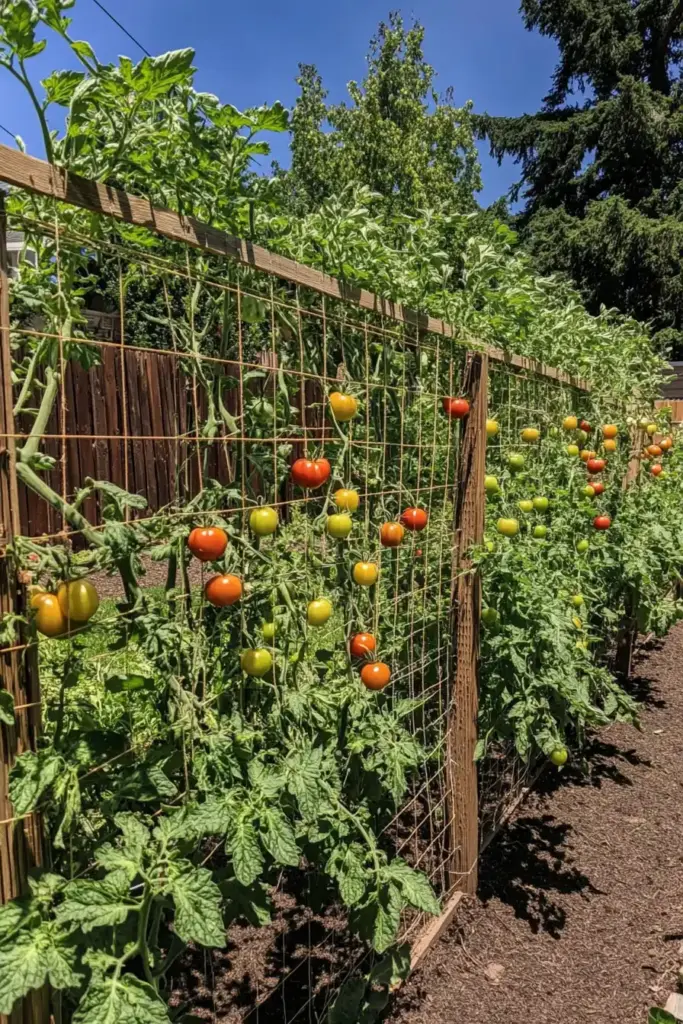
Choosing the right trellis can transform the way you grow tomatoes. From the simplicity of a single stake to the structured elegance of an A-frame or the efficiency of the Florida Weave, there’s a solution for every space and skill level. The key is to match your plant variety, garden layout, and available time to the trellis method that fits best. With these beginner-friendly tomato trellis ideas, you’ll enjoy healthier plants, easier maintenance, and a more bountiful harvest — all while keeping your garden neat and thriving.
Happy growing — may your tomatoes grow tall, strong, and delicious!

